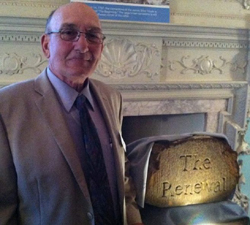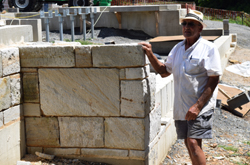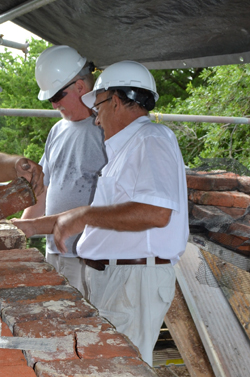Raymond J. Cannetti: Master Brick and Stone Mason
 Raymond J. Cannetti is a master brick and stone mason with expertise in historic buildings. His projects have included James Madison’s Montpelier, Historic Mount Vernon, the Wren Building at The College of William and Mary, and the World War II Memorial. He has also worked on reconstructions, including Charlton’s Coffee House for The Colonial Williamsburg Foundation and Washington’s Boyhood Home for the George Washington Foundation. Mr. Cannetti’s business is based in St. Mary’s City, Maryland.
Raymond J. Cannetti is a master brick and stone mason with expertise in historic buildings. His projects have included James Madison’s Montpelier, Historic Mount Vernon, the Wren Building at The College of William and Mary, and the World War II Memorial. He has also worked on reconstructions, including Charlton’s Coffee House for The Colonial Williamsburg Foundation and Washington’s Boyhood Home for the George Washington Foundation. Mr. Cannetti’s business is based in St. Mary’s City, Maryland.
What led you to your field?
After graduating from high school, I got a job as a masonry laborer for a company out of Hagerstown, Maryland. After a short period, they needed more bricklayers and offered me an apprenticeship. After completing that, I wanted to know more. I then apprenticed as a stone mason for a company in Washington, D.C. I still wanted to know more.
Having come from a long line of stone carvers (not my dad, the rebel. He was involved in aviation electronics for the Navy), I wanted to learn stone carving. I got a job in a stone mill in Washington, D.C. called the Cathedral Stone Co. It was owned by the Washington National Cathedral but run by a private individual named Dennis Rude. There I learned stone cutting and carving. While there I also became involved in the conservation and repair of historic stone.
My interest in historic masonry started almost 40 years ago while working for an archaeologist stabilizing ruins in Saint Mary’s City.
How does what you do relate to historic preservation?
Although what I do is mostly at the end of the preservation process, I am increasingly asked to be involved in the architectural research and planning processes. This is mostly to maintain a high level of accuracy of detail in workmanship and materials, for both reconstruction and restoration projects.
I also consult for private owners and small museums.
Why do you think historic preservation matters?
Like one of your past interviewees, I clearly recognized the importance of: “to know where you are going, you need to know where you come from.”
What courses do you recommend for students interested in this field?
Anything that Norman Weiss at Columbia University teaches or any workshop offered by John Walsh of Highbridge Materials Consulting or Graham Coleman in England. Don’t get all of your information from a materials salesperson. Get it from someone with knowledge. Just as important, learn the skill yourself. It is the one weak point I have found with all academically trained workers. Their knowledge of materials and how they work is great, but the skill aspect is just as if not more important.
Do you have a favorite preservation project? What about it made it special?
This is a difficult question to answer because I have been able to work on so many challenging restorations and reconstructions. Some of the projects were special because they allowed me to make a difference in the region where I was working. Historic masonry is not like modern masonry: it involves different materials, tooling finishes, assembly, and causes for masonry failure. At the beginning of the restoration of Madison’s Montpelier, which is located in an area with many early buildings, we hired local skilled masons who would work under my direction to learn how to properly work on early masonry. The intention was to create a competent resource to work on all early masonry buildings, not just museums.
Can you tell us what you are working on right now?
I am currently working on the reconstruction of George Washington’s boyhood home at Ferry Farm in Fredericksburg, Virginia. It is one of the most challenging projects I have worked on. This is my third summer assisted by two very good and dedicated masons: Kevin Nieto and Robert Hall. The first year was spent splitting 35-ton boulders of Aquia sandstone into ashlar blocks (a uniform rectangle shape). We worked about 100 tons, making about 400 ashlar blocks, all hand finished. Aquia sandstone is the same stone the White House and the US Capitol were built from in the late 1700s. It was also used in earlier buildings in the Chesapeake region. It was quite desirable by the wealthy as an expression of status and patriotism.
The second year we reconstructed the house foundation with the ashlar blocks and stabilized what survived of the original stone in the cellar. We then reconstructed what was missing.
This is the third year, and we are now reconstructing the brick chimneys with 26,000 handmade reproduction bricks from Old Carolina Brick and the brickyard at Colonial Williamsburg.
The brickyard in Colonial Williamsburg has also burned us a large quantity of oyster shell that we are slaking on site to make mortar. (The process of heating and submerging oyster shells in water causes a chemical reaction that results in a paste. Over time, the paste will return to a hardened state. For more information, view a National Park Service clip here: https://www.youtube.com/watch?v=W44oWDto4Z8).
When finished, Ferry Farm will have a great story to tell about the influences and activities of a young man who would grow up to be: “First in war, First in peace, and First in the hearts of his countrymen.”
The George Washington Foundation’s website has photos and video of all phases of the project to date. (See here: http://www.kenmore.org/ff_home.html).
How do you think the national historic preservation programs help your community?
 From my perspective, education is key. Historic masonry, stone, brick, and tile are very different from modern materials. Restoring places or just regular maintenance is not just about the past, it’s about the future of that structure. The Department of the Interior has taken the lead in helping communities to educate themselves, but it’s a process that is never done.
From my perspective, education is key. Historic masonry, stone, brick, and tile are very different from modern materials. Restoring places or just regular maintenance is not just about the past, it’s about the future of that structure. The Department of the Interior has taken the lead in helping communities to educate themselves, but it’s a process that is never done.
Tax credit programs and grants for private owners provide small but important compensation for what owners contribute from their own pockets and personal lives to preserve their homes.
These owners all want to do the right thing when it comes to taking care of their homes. Advice that is educational, practical, and affordable can help owners live in and reduce the cost of maintaining their homes.
Do you have advice for novice preservationists?
Learn the skills. Never grow tired of challenging yourself.
The ACHP’s mission is "preserving America’s heritage;" can you give us an example of how your community is preserving its heritage?
This is another tough question I feel I am not able to answer directly, but I do have an opinion of why I think it is important.
From working in many different communities, I feel that all local history has created national history. The stories they tell seem to all be connected - good or bad - and have created the path that has gotten us to where we are today. This comes back to the earlier question that to know where you are going it helps to know where you have come from.
I do have a story.
It was the 1990s, a beautiful spring day, and I was working on the mansion at Mount Vernon. A group tour came by and the interpreter leading the tour asked the group a question: “If George Washington was alive today, what do you think he would be most surprised to see?” Like the people in the tour, I was thinking of automobiles, airplanes, space travel, modern medicine, and so many other things. Her answer was the simple fact that the country based on the founders’ vision has survived.
I will never forget that day.
How do stonemasonry and heritage craftsmanship play a role in historic preservation?  Through demonstration, I think all historic trades play some role in connecting the public to the past. More importantly, they help people understand the difference between modern and historic building methods and materials.
Through demonstration, I think all historic trades play some role in connecting the public to the past. More importantly, they help people understand the difference between modern and historic building methods and materials.
Today, most homeowners can work on their own homes. Materials are available that are packaged for easy transport and can be expertly installed with simple tools and a basic understanding of assembly.
In the 18th century less than 5 percent of the population was living in homes considered permanent. Those who did not (95 percent) were, much like today, building and working on their own homes. Instead of “Home Depot” there was “Natural Resources Depot.” It was important to be able to recognize the proper trees for making shingles for your roof or for making your frame, to know what type of stone to use or where a supply of shell could be found to burn to make lime for mortar, where to find clay for brick, and so on. This is the importance of heritage craftsmen: these men and women understand early buildings, how to properly preserve them, and how to find the right resources for the job.
Read more Q&A stories about the preservationists in your neighborhood!